Institutions of higher education have increasingly embraced online education, and the number of students enrolled in distance programs is rapidly rising in colleges and universities throughout the United States. In response to these changes in enrollment demands, many states, institutions, and organizations have been working on strategic plans to implement online education. At the same time, misconceptions and myths related to the difficulty of teaching and learning online, technologies available to support online instruction, the support and compensation needed for high-quality instructors, and the needs of online students create challenges for such vision statements and planning documents.
In part, this confusion swells as higher education explores dozens of e-learning technologies (for example, electronic books, simulations, text messaging, podcasting, wikis, blogs), with new ones seeming to emerge each week. Such technologies confront instructors and administrators at a time of continued budget retrenchments and rethinking. Adding to this dilemma, bored students are dropping out of online classes while pleading for richer and more engaging online learning experiences.1 Given the demand for online learning, the plethora of online technologies to incorporate into teaching, the budgetary problems, and the opportunities for innovation, we argue that online learning environments are facing a "perfect e-storm," linking pedagogy, technology, and learner needs.2
Considering the extensive turbulence created by the perfect storm surrounding e-learning, it is not surprising that opinions are mixed about the benefits of online teaching and learning in higher education. As illustrated in numerous issues of the Chronicle of Higher Education during the past decade, excitement and enthusiasm for e-learning alternate with a pervasive sense of e-learning gloom, disappointment, bankruptcy and lawsuits, and myriad other contentions.3 Appropriately, the question arises as to where online learning is headed. Navigating online education requires an understanding of the current state and the future direction of online teaching and learning.
The study described here surveyed instructors and administrators in postsecondary institutions, mainly in the United States, to explore future trends of online education. In particular, the study makes predictions regarding the changing roles of online instructors, student expectations and needs related to online learning, pedagogical innovation, and projected technology use in online teaching and learning.
Review of Literature
We began this project with a review of past studies of the issues and trends in online teaching and learning in higher education.
Online Teaching and Learning
A recent survey of higher education in the United States reported that more than 2.35 million students enrolled in online courses in fall 2004.4 This report also noted that online education is becoming an important long-term strategy for many postsecondary institutions. Given the rapid growth of online education and its importance for postsecondary institutions, it is imperative that institutions of higher education provide quality online programs.
The literature addresses student achievement and satisfaction as two means to assess the quality of online education. Studies focused on academic achievement have shown mixed reviews,5 but some researchers point out that online education can be at least as effective as traditional classroom instruction.6 Several research studies on student satisfaction in online courses or programs reported both satisfied and dissatisfied students.7
Faculty training and support is another critical component of quality online education. Many researchers posit that instructors play a different role from that of traditional classroom instructors when they teach online courses,8 as well as when they teach residential courses with Web enhancements.9 Such new roles for online instructors require training and support. Some case studies of faculty development programs indicate that such programs can have positive impacts on instructor transitions from teaching in a face-to-face to an online setting.10
Pedagogy and Technology for Online Education
Several research studies have covered effective pedagogical strategies for online teaching. Partlow and Gibbs, for instance, found from a Delphi study of experts in instructional technology and constructivism that online courses designed from constructivist principles should be relevant, interactive, project-based, and collaborative, while providing learners with some choice or control over their learning.11 Additionally, Keeton investigated effective online instructional practices based on a framework of effective teaching practices in face-to-face instruction in higher education. In this study, Keeton interviewed faculty in postsecondary institutions, who rated the effectiveness of online instructional strategies. These instructors gave higher ratings to online instructional strategies that "create an environment that supports and encourages inquiry," "broaden the learner's experience of the subject matter," and "elicit active and critical reflection by learners on their growing experience base."12
In another study of pedagogical practices, Bonk found that only 23–45 percent of online instructors surveyed actually used online activities related to critical and creative thinking, hands-on performances, interactive labs, data analysis, and scientific simulations, although 40 percent of the participants said those activities were highly important in online learning environments.13 In effect, a significant gap separated preferred and actual online instructional practices.
Technology has played and continues to play an important role in the development and expansion of online education. Accordingly, many universities have reported an increase in the use of online tools. Over the past decade, countless efforts have sought to integrate emerging Internet technologies into the teaching and learning process in higher education. Several studies have reported cases related to the use of blogs to promote student collaboration and reflection.14 Some researchers also have promoted the plausibility of using wikis for online student collaboration,15 and podcasting is beginning to garner attention from educators for its instructional use.16 Although some discussions in the literature relate to effective practices in the use of emerging technologies for online education, empirical evidence to support or refute the effectiveness of such technologies, or, perhaps more importantly, guidance on how to use such tools effectively based on empirical evidence, is lacking.
Method
This study was based on a survey of individuals believed to have relevant experience with and insights into the factors affecting the present and future state of online education.
Participants
An online survey was conducted of college instructors and administrators who were members of either the Multimedia Educational Resource for Learning and Online Teaching (MERLOT) or the Western Cooperative for Educational Telecommunications (WCET), both premier associations for online education. MERLOT is a free and open resource for higher education with membership that, at the time of this study, included more than 12,000 college professors, instructional designers, and administrators who share and peer-evaluate their Web resources and materials (today, MERLOT has more than 35,000 members). WCET is an organization with 500–600 members that provides resources and information regarding the effective use of telecommunications technology in learning. Also surveyed were those who had posted one or more course syllabi at the World Lecture Hall (WLH), which has approximately 2,000 members and was developed by the University of Texas for faculty to share syllabi.
This study is a part of a longitudinal effort to understand the use of technology in teaching, within both higher education and corporate training settings. The second author had previously surveyed MERLOT and WLH members on the state of online learning17 as well as corporate trainers on online training18 and blended learning.
Instrument
Using an online survey service, SurveyShare, we developed an online questionnaire as an instrument for this survey study. The questionnaire consisted of 42 questions grouped into three sections related to the current status and future trends of online education in higher education. The first section included 10 questions regarding respondents' demographic information. The second section included seven questions about the current status of online learning at the respondents' organizations. The third section included items regarding predictions about online teaching and learning. The survey used various types of questions, including Likert-type, multiple-choice, and open-ended questions.
Data Collection and Analysis
The survey took place from late November 2003 to early January 2004. An invitation was sent by e-mail to the sample of instructors, instructional designers, and administrators described earlier. The e-mail included information about the study as well as the URL to the survey site. Of more than 12,000 who received the e-mail request, 562 completed the survey. The participants responded to the survey anonymously, and the data were stored in the hosted online survey service. Descriptive data analyses (such as frequencies) were conducted using the data analysis tool provided in the online survey site.
Results
Our study confirmed some commonly held beliefs about online education, refuted others, and provided a range of predictions about the future of technology-enabled education.
Demographics of Online Instructors
Sixty-six percent of the survey respondents held teaching positions (professors, instructors, or lecturers), while nearly one-fourth were administrators or instructional designers. Respondents represented institutions of various types: approximately half were employed by public, four-year colleges or universities; 23 percent by community colleges or vocational institutes; and 16 percent by private postsecondary institutions. A large majority (87 percent) said their institutions offer online courses, and about 70 percent of them had taught online courses.
As shown in Figure 1, respondents' experience with online teaching varied from none to more than 10 years. Although not every respondent had online teaching experience, more than 95 percent had experience integrating computer or Web technology into their face-to-face teaching.
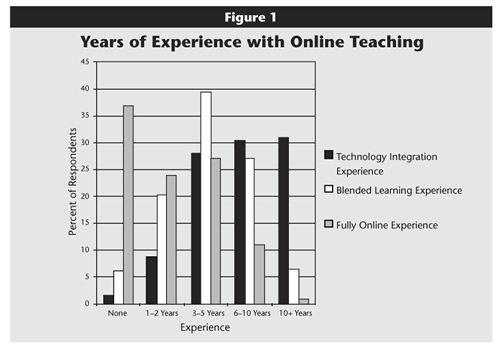
Click image for larger view.
Survey results show that women appear to be teaching online in far greater numbers than just a few years ago. In fact, more than half of the respondents (53 percent) were women. Such findings were surprising because a similar study conducted a few years earlier was dominated by male instructors who were full professors at tier-one universities.19 Perhaps female instructors had become more comfortable teaching and sharing activities online during the few years that elapsed between surveys, or perhaps support for instructors had improved on college campuses, or both.
Emerging Technology
When asked about several emerging technologies for online education, 27 percent of respondents predicted that use of course management systems (CMSs) would increase most drastically in the next five years. Those surveyed also said that video streaming, online testing and exam tools, and learning object libraries would find significantly greater use on campus during this time. Between 5 and 10 percent of respondents expected to see increases in asynchronous discussion tools, videoconferencing, synchronous presentation tools, and online testing.
The survey also asked what technology would most impact the delivery of online learning during the next five years. Respondents could select one of 14 key technologies. About 18 percent of respondents predicted that reusable content objects and wireless technologies would have the most significant impact. Smaller percentages (from 7 to almost 14 percent) selected peer-to-peer collaboration, digital libraries, simulations and games, assistive technologies, and digital portfolios. In contrast, less than 5 percent predicted that e-books, intelligent agents, Tablet PCs, virtual worlds, language support, and wearable technologies would have significant impact on the delivery of online learning. These findings seem to reflect the perceived importance of online technologies for sharing and using preexisting content.
Additionally, respondents predicted that advances in Internet technology (for example, greatly extended bandwidth and wireless Internet connections) are likely to increase the use of multimedia and interactive simulations or games in online learning during the next five to 10 years. Only about one in 10, however, predicted that advances in Internet technology would enhance videoconferencing or international collaboration, and just one in 16 thought it might offer greater chances to interact with field experts or practitioners. Again, the focus was on enhancing content and associated content delivery, not on the social interactions, cross-cultural exchanges, or new feedback channels that wider bandwidth could offer. Such responses indicate that respondents still see learning as content-driven, not based on social interactions and distributed intelligence. The emphasis remains on a knowledge-transmission approach to education, not one rich in peer feedback, online mentoring, or cognitive apprenticeship.
Enormous Learner Demands
Our study revealed a number of trends related to areas of growth in online education, future needs for online instructors, and the dominance of online versus face-to-face instruction.
Growth of Online Programs/Degrees. Comparing current online offerings and projected future online offerings at respondents' institutions yields predictions about the areas of growth in online programs and degrees. Most respondents expected considerable growth in online certification and recertification programs in the next few years, as well as in associate's degrees. Yet, our survey respondents predicted little growth in the number of institutions that offer online master's or doctoral programs in the future. Although more than half of the respondents (54 percent) expected that their institutions would offer online master's or doctoral programs in the coming years, almost the same number of respondents (53 percent) reported that their institutions were presently offering online master's or doctoral programs. In contrast, respondents predicted that certification and recertification programs would see 10–20 percent growth from present offerings. Such responses indicate that higher education institutions might be wise to explore certificate and short-program offerings rather than full degree programs.
Online Instructors' Readiness. Will online instructors be ready to meet the challenges brought by the projected increases in learner demands for online education? About half of the respondents predicted that monetary support for and pedagogical competency of online instructors would most significantly affect the success of their online programs (see Table 1). In addition, instructors' technical competency was the third most pressing factor. Nevertheless, as illustrated in Table 2, pedagogical skill was deemed more important than technological skill for effective online teaching. With regard to the needs for pedagogical competency of online instructors, a majority of the respondents expected that online instructors would typically have received some sort of training in online teaching either internally or externally by the year 2010.
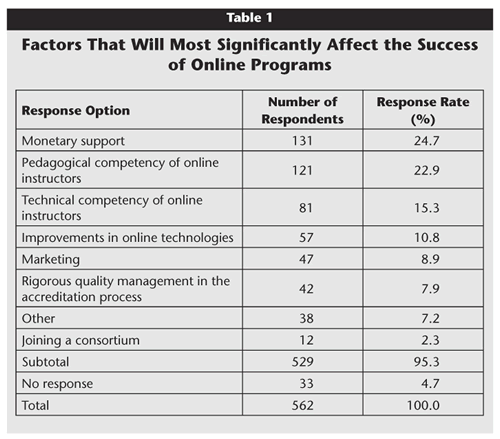
Click image for larger view.
The Rise of Blended Learning. The survey asked respondents for their predictions related to the growth of online education in the next few years. Respondents indicated that more emphasis is expected on blended learning—instruction that combines face-to-face with online offerings—than on fully online courses. Those surveyed predicted a distinct shift from about one-quarter of classes being blended today to perhaps the vast majority of courses having some Web component by the end of the decade (see Figure 2).
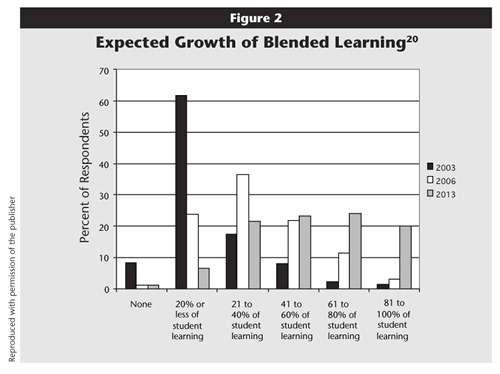
Click image for larger view.
Enhanced Pedagogy
Although the use of CMSs in higher education has increased rapidly and is likely the foundation for the rapid increase in the number of online learners during the past decade,21 some researchers argue that CMSs are promoted as ways to manage learners rather than to promote rich, interactive experiences.22 As a result, enhancing pedagogy is perhaps the most important factor in navigating the perfect e-storm. In the present study, respondents made predictions about the quality of online education in the near future and about how online courses would be taught and evaluated.
The Quality of Future Online Education. Survey respondents generally agreed with recent Sloan reports that the quality of online education will improve in the future.23 Sixty percent of respondents expected that the quality of online courses would be identical to traditional instruction by the year 2006 (see Figure 3). Also, a majority of the respondents predicted that the quality of online courses would be superior to (47 percent) or the same as (39 percent) that of traditional instruction by 2013. Only 8 percent predicted that the quality of online courses would be inferior in 2013.
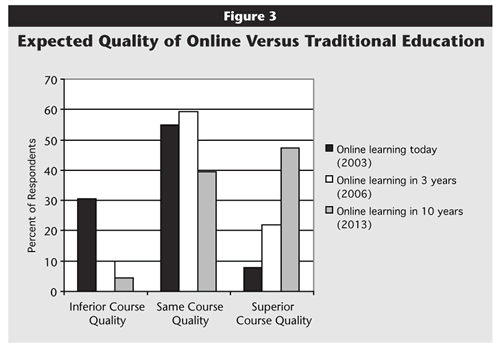
Click image for larger view.
Similarly, a large majority of respondents predicted that learning outcomes of online students would be either the same as (39 percent) or superior to (42 percent) those of traditionally taught students by 2013. In effect, the trend is for course quality and learner outcomes to steadily and significantly improve during the coming decade. Although we did not ask about reasons for the increase in quality, such numbers should be interesting and valuable to administrators, instructors, students, and other online learning stakeholders.
In terms of factors that can improve online learners' success, respondents said that training students to self-regulate their learning (22 percent) was needed most, followed by better measures of student readiness (17 percent), better evaluation of student achievement (17 percent), and better CMSs to track student learning. Nine percent said additional technology training is needed. This concern about learner self-regulation is ironic in a world dominated and driven by learning management systems that are primarily used to manage students, as alluded to earlier. Follow-up surveys might address whether learners perceive this mixed message and whether they prefer to be managed online or engage in more self-directed online environments.
As Carmean and Haefner argued, there is a need for CMS environments that foster deeper student learning and engagement.24 They noted that such environments might foster student choice among various activities, reflection, apprenticeship, synthesis, real-world problem solving, and rich, timely feedback. More recently, Weigel added to this argument by suggesting that the next-generation CMS should foster a more learner-centered environment that rich in critical thinking, student exploration, peer learning and knowledge construction, interdisciplinary experiences incorporating a community of educators (practitioners, business leaders, alumni, and others), and educational opportunities.25
Online Teaching Skills. Instructors' abilities to teach online are critical to the quality of online education. Unlike our earlier study related to the state of online learning in 2001, which included many questions about online learning tools and features, the present study focused more on learning outcomes and pedagogical skills. For instance, this study found that the most important skills for an online instructor during the next few years will be how to moderate or facilitate learning and how to develop or plan for high-quality online courses (see Table 2). Being a subject-matter expert was the next most important skill. In effect, the results indicate that planning and moderating skills are perhaps more important than actual "teaching" or lecturing skills in online courses. As Salmon pointed out, online instructors are moderators or facilitators of student learning.26
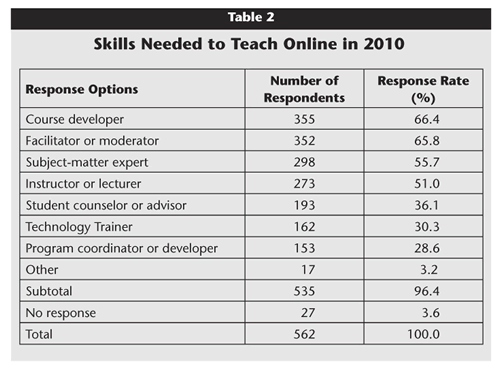
Click image for larger view.
Pedagogical Techniques. Over half of the survey respondents predicted that online collaboration, case-based learning, and problem-based learning (PBL) would be the preferred instructional methods for online instructors in the coming decade. In contrast, few respondents expected that instructors would rely on lectures, modeling, or Socratic instruction for their online teaching in the future (see Table 3). In other words, survey respondents predicted that more learner-centered techniques would be used in the future, indicating a marked shift from traditional teacher-directed approaches.
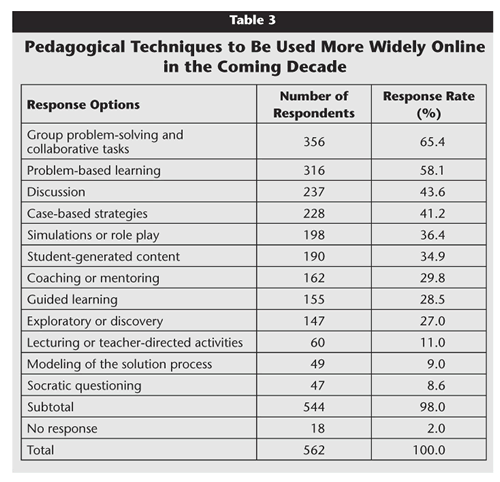
Click image for larger view.
Existing research indicates that online instructors tend to use easy-to-implement tools, resources, and strategies rather than complex PBL, virtual teaming, cross-cultural collaboration, simulations, and other forms of rich interactive media.27 If the prediction for more learner-centered pedagogies online is realized, it would be interesting to study whether those teaching online transfer such pedagogical skills to their face-to-face instructional activities.
Our findings also indicated that, in general, respondents envisioned the Web in the next few years more as a tool for virtual teaming or collaboration, critical thinking, and enhanced student engagement than as an opportunity for student idea generation and expression of creativity. This is not surprising, given that most instruction in higher education is focused on consumption and evaluation of knowledge, not on the generation of it. Perhaps online training departments and units need to offer more examples of how to successfully embed creative and generative online tasks and activities.
Evaluation and Assessment of Online Courses. Evaluation is an important part of ensuring the quality of online courses and programs. Table 4 summarizes respondents' predictions about future trends concerning the evaluation of online learning. When asked how the quality of online education will be most effectively measured during the coming decade, 44 percent answered that a comparison of online student achievement with that of students in face-to-face classroom settings would be the most effective, followed by student performance in simulated tasks of real-world activities (15 percent), calculations of return on investment (10 percent), and student course evaluations (9 percent). Clearly, respondents believe that face-to-face instruction provides a valid benchmark for teaching and learning outcomes and that online performance should at least equal its effectiveness. Such views, while politically important, seem to forget that much of the learning that occurs online could not take place in a face-to-face delivery mode (for example, asynchronous online discussions or online mentoring). It also assumes that face-to-face instruction is superior. What if institutions took the opposite stance and measured face-to-face courses based on whether they could accomplish all that online instruction can?
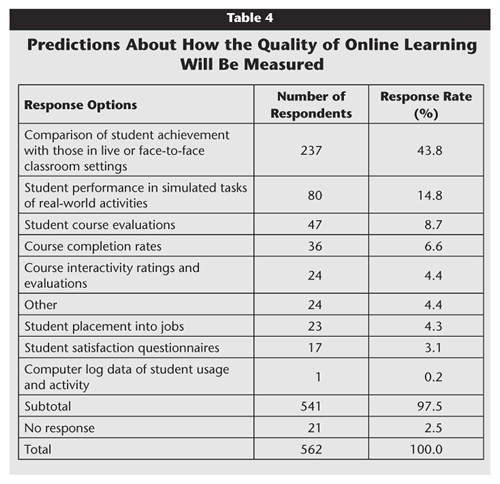
Click image for larger view.
As for the forms of evaluation that will be used during the next few years, respondents predicted that online practice quizzes and exams would be most highly used, followed by online surveying and polling, course evaluations, and online quizzes and exams. In particular, more than 90 percent of the respondents predicted that online surveys would be used as an important student research tool or as a teaching device in addition to student assessment and course evaluation. This finding affirms our belief that online surveys offer the chance to be learner-centered because they allow students to collect, analyze, and report on real-world data and projects.
Discussion and Conclusion
As institutions of higher education continue to embrace and debate online learning, it is important to envision where the field is headed. What might the next generation of online learning environments look like? Will they move from warehousing students in online environments to engaging them in interactive and motivational activities? What technological and pedagogical advantages will they offer? Current studies provide a glimpse of the pedagogical and technological possibilities. Clearly, we are entering a unique and exciting era in online teaching and learning. And perhaps the perfect e-storm is becoming less cloudy and ominous.
Implications of the Findings
Institutions of higher education need to consider whether they are ready to meet growing learner demands in the coming years. First of all, most respondents agreed that blended learning would have greater significance in higher education in the future. Although some institutions have already embraced blended learning, many others are slower at adopting it for various reasons. Perhaps leadership from the institution is crucial for faculty to receive adequate support to implement changes in the teaching process.
If the quality of online education is to improve as projected from this study, campuses must also look at the pedagogical issues in online learning. Collaboration, case learning, and PBL are likely to be the preferred methods of online instructors, with few relying solely on traditional methods. The data presented here also indicate that the continued explosion in online learning will bring increased attention to workshops, courses, and degree programs in how to moderate or mentor with online learning. Given that many respondents expect to receive some sort of training and support from their institutions to be ready for online teaching, colleges and universities need to consider how they will respond to these needs.
In addition, our study indicates that postsecondary institutions are finally focusing on how online learning can develop student collaboration and evaluation skills. In fact, most now see the potential of the Web in the coming years as a tool for virtual teaming or collaboration, critical thinking, and enhanced student engagement, though not necessarily as a tool for creative and individual expression. Do current CMSs provide tools to realize the potentials of the Web for innovative teaching and learning? Perhaps recent developments in open source courseware will force CMS vendors to develop and market more pedagogically engaging tools and resources.
This survey also forecasts enormous growth in online certification and recertification programs, as well as some growth in associate's and master's degree programs during the coming decade. In terms of technology, the study reveals interest among online instructors in wireless technologies, simulations, digital libraries, and reusable content objects. Perhaps we are entering a world where learning objects will be at our fingertips. Learning objects on different topics will likely be something you can grab like magazines and newspapers on the way into a plane, bus, or train. In addition, as bandwidth increases with the next-generation Internet technologies and capabilities, simulation and gaming tasks that online students engage in will be more realistic and authentic.
Study Limitations and Recommendations for Research
More than two years have passed since we conducted the survey. This time gave us the opportunity to see how the predictions our survey respondents made have played out. We have continued to witness accelerating growth of learner demands for online learning as well as the potential for enhanced online pedagogy due, in part, to the recent open source movement. Predictions related to emerging technologies seem to have been inaccurate, given that only 1 percent said that the use of blogs would increase dramatically by 2008. Given the thousands of new blogs each day, it is safe to say that this prediction did not hold.
This study did not explore actual online teaching and learning practices. It is likely that some responses were related to recent fads that may or may not be sustainable. In addition, we did not survey students for their perceptions of online learning trends and possibilities. A study of students might indicate that they deem different technologies to be important and on the cusp of significant growth. In a learner-centered world, who can better predict technology trends today—instructors or students? This study also indicated that blended learning will perhaps be a more significant growth area than fully online learning. Follow-up studies might focus on aspects of blended learning that institutions need to address, such as types of blended learning, activities that lead to blended-learning success, and instructor training for blended-learning situations.28
